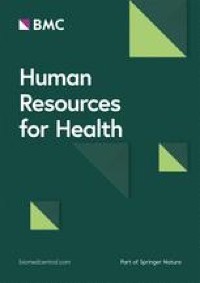
Global trends in HMR in healthcare
Our study of HMR research in healthcare illustrates current and global trends in publications, contributing countries, institutions, and research orientations. The field of HMR research has evolved over the past three decades. However, as this study shows, the number of publications steadily increases yearly, with 93 countries or regions publishing in the field, suggesting that research focusing on HMR research and providing in-depth knowledge will likely increase.
Quality and status of publications worldwide
We find that most publishing countries are developed countries, but developing countries are catching up. The total citation rate and the h-index reflect the quality and scholarly impact of a country’s publications [25]. According to our study, the US ranks first among other countries in total publications, citations, and h-index, making the most substantial contribution to global HRM research. The UK and Canada also contribute significantly, with impressive total citation frequencies and h-index, especially the UK, which ranks second in average citation frequency. However, some countries, such as Belgium, Canada and Australia, also play an important role, given their high average citation frequency. In developing countries, HRM research has also served as a guide for hospitals to improve the quality of care. The study will serve as a reference for developing countries to learn from the experience of developed countries as their economic development gradually catches up with that of developed countries.
The impact and prestige of the journals can be seen in the number of articles published in the field and the influential journals in healthcare HRM research, including the BMC Health Services Research, the Journal of Nursing Management, the International Journal of Human Resource Management, the Health Care Management Review, and the Journal of Health Organisation and Management. These high-quality journals are thus the main source of information for researchers in this field on the latest developments in HRM in healthcare.
The study shows that almost all of the top 20 institutions come from the top five countries with the most publications, with the majority coming from the US, Australia and the Netherlands, reflecting the great academic influence of these three countries in the field of HRM in healthcare. These institutions play an important role in raising the academic performance of a country. Furthermore, the top 20 authors represent research leaders who are likely to impact the future direction of research significantly. Therefore, more attention should be paid to their work to stay abreast of the latest developments in the field.
Research Focus on HRM
Keywords play a crucial role in research papers as they contain vital information [26]. A systematic analysis of keywords within a specific research domain offers valuable insights into trends and focal points across various research areas [27]. Moreover, co-occurrence analysis relies on the number of joint publications to evaluate relationships among the identified keyword domains. As a result, it serves as an effective method for predicting future trends and focal points within the research areas of interest. These findings are expected to inspire more researchers to contribute to the future of HRM research in healthcare [28].
In this study, a total of six research domains were eventually summarized. Performance, Hospital/COVID-19, Job Satisfaction, Human resource management, Occupational/Mental Health, and Quality of care. By visualizing the analysis results, we can easily further clarify future trends. As the co-occurrence diagram shows, the keywords “Organizational culture”, “Patient safety”, “Nursing”, “Leadership”, “Quality of care” and “Hospitals” are highlighted as larger icons, so that investment and demand for quality research are necessary for the context of these six research directions.
Six modules and research directions in human resources
This study found that the visual clustering results and the keywords that emerged from the clusters were closely related to the HRM modules described in “Human Resources Management: Gaining a Competitive Advantage” by Noe. R. [29]. The modules have been cited in HRM research and are used as textbooks in universities [30,31,32,33]. Some of the keywords in each cluster correspond to human resource planning, performance management, recruitment and staffing, and training and development, respectively. The explanation of the HRM modules is described in the next paragraph. However, there are no explicit keywords in the modules related to employee relations management and compensation management results. This may be due to the private nature of the compensation structure in healthcare organizations during data collection, making it unavailable.
The explanation of the HRM modules [29]
-
(1)
Human resource planning is the starting point of HRM. It helps the organization forecast future personnel needs and their basic qualities, primarily through planning.
-
(2)
Recruitment and staffing, with HR planning as the input, is equivalent to the organization’s blood, nourishing the organization and solving the problem of staffing and staff matching.
-
(3)
Training and development, with the “education” theme.
-
(4)
Performance Management is at the heart of the six dimensions. It is also the primary input to the other dimensions.
-
(5)
Compensation management aims to motivate employees to solve the company’s problems.
-
(6)
Employee relations management aims to manage people and help the company form an effective cycle of rational human resource allocation.
Human resource planning
Human Resource Plan (HRP) stands for the implementation of the HR development strategy of the enterprise and the accomplishment of the enterprise’s goals, according to the changes in the internal and external environment and conditions of the enterprise, through the analysis and estimation of the future needs and supply of human resources and the use of scientific methods for organizational design, as well as the acquisition, allocation, utilization and maintenance of HR and other aspects of functional planning. HRP ensures that the organization has a balance of HR supply and demand at a needed time and in a required position, and achieves a reasonable allocation of HR and other resources to effectively motivate and develop of employees [34].
Decentralization health system, organizational culture/structure are high-frequency words in the clustering results related to “human resource management”. It is important to assess the extent to which decentralization can be used as a policy tool to improve national health systems. For policymakers and managers, based on relevant literature and research as well as country experience analysis, the experience of decentralization in relation to the organization and management of healthcare services is considered a forward-looking and pioneering concept capable of achieving optimal allocation of HR and other resources, in addition to the need to focus more on ex-ante and ex-post incentive development to deliver a 1 + 1 > 2 HRM effect [35]. HRP is the starting point and basis for all specific HRM activities. It directly affects the efficiency of the overall HRM of the enterprise. It is, therefore, taken as the primary job requirement for HR managers [36]. Organizational culture/structure significantly impacts the healthcare sector, such as excellence in healthcare delivery, ethical values, engagement, professionalism, cost of care, commitment to quality and strategic thinking, which are key cultural determinants of high-quality care delivery [37]. Therefore, as with other for-profit organizations, healthcare organizations must ensure that their organizational structure functions effectively to achieve their strategic goals. The organization formulates and implements HRM, an important task to achieve the development strategy goals.
Staff recruitment and allocation
Recruitment and staffing are the first steps in hospital HRM activities. Under the guidance of the organization’s human resources development plan, potential staff who meet the development conditions are attracted. Through the scientific selection of outstanding personnel, a platform with guaranteed treatment and development prospects is provided to ensure that the team of the healthcare organization is built solidly and meets the development needs. From the findings of this study, the keywords “workforce” and “workload” appear as high-frequency keywords in the co-occurrence analysis. Still, keywords related to traditional staff recruitment (e.g., analysis of recruitment needs, job analysis, competency analysis, recruitment procedures, and strategies) do not appear often. Recruitment and staffing are the prerequisites of human resources work. They bring a new dynamic source to healthcare organizations while complementing staff, making the organization full of vitality and vigor, facilitating organizational innovation and management innovation and helping improve the healthcare organization’s competitive advantage [38]. Recruitment and staffing, as a part of HR, directly impact the successful running of daily activities.
Training and development
Human resource training is an important component of quality and safety in the health care system. The keyword “education and training” shows a high frequency of co-occurrence in the clustering results of analysis, corresponding to the module “training and education”. However, it is connected to the keywords “human resource management” and “health policy”, and is in the same cluster with” public health”, “health care management”, and the distance between the lines and dots indicate that these topics are closely related, proving the importance of education and training in the HRM of health systems. Healthcare organizations (especially for non-professionals and caregivers) can improve the performance of their employees by enhancing their capabilities, knowledge and potential through learning and training, so that they can maximize their qualifications to match the demands of their work and advance their performance [39, 40].
Performance management
Performance management, the core of the six modules, is also featured in the clustering results. Although this is an important focus for HR professionals, few studies have explored the link between HRM and health sector performance [6], the results show “performance” and “motivation”. The effectiveness of performance management is an important component of HRM, which effectively improves the quality of care in healthcare organizations/institutions [6]. Focusing on the effectiveness of performance management is considered to be crucial. First, as an integral part of HRM within an organization, it can help the organization meet its goals. Second, ineffective approaches can lead to negative attitudes among employees (including clinicians, nursing staff, administrators, etc.) and adversely affect performance due to decreased satisfaction among employees and patients. Third, given the increasing quality and cost reduction pressures on healthcare organizations, conducting further research on performance management and effectiveness is critical [41]. However, it is clear from our results that healthcare organizations have recognized the importance of performance management and are pursuing “high performance”. Although the topic of performance management in HRM in healthcare is one of the research priorities, the number is lacking and more discussion on performance management should be suggested for future research.
Compensation management
Compensation is an important tool to motivate employees to work hard and to motivate them to work hard. The results of the database’s bibliographic analysis show that no keywords directly involved compensation. This indicates that “compensation management” has not been considered a hot topic or a research issue over 30 years of available literature. To clarify the content of this module, we further searched the database of 718 articles with keywords, such as compensation, remuneration, salary, etc., and found that only 35 of them mentioned or discussed compensation, and some years (e.g., 2018, 2009) even had no relevant literature being published. However, issues such as fairness of compensation management and employee compensation satisfaction are still important issues of concern to business management academics [42, 43]. The actual situation is that it is difficult to conduct research on compensation management. Most organizations keep their employees’ compensation confidential, and when conducting research, HR managers avoid talking about their employees’ compensation or leave it vague, rendering it impossible for researchers to conduct further research.
Employee compensation is one factor that has the greatest impact on organizational performance. In the future, organizations should be encouraged to scientifically structure their compensation management and empower academic research to establish and implement fair compensation management systems based on empirical research while maintaining the privacy and security of organizational information.
Employee relations management
The connotation of employee relations management involves organizational culture and employee relations, as well as the coordination of the relationship between employers and employees. Healthcare organizations have complex structures with employees with varying skills, tasks or responsibilities, and such conflicts are often managed through the communication skills of administrative staff [44]. Although the keywords related to “employee relations management” did not occur in this study’s analysis results, the six HRM modules are closely related. Therefore, this does not mean that no description of employee relations management was completely absent in the retrieved articles. It is clear that there is currently a lack of research on employee relations management in the healthcare field. Still, with the continuous development of the healthcare industry, it faces multiple challenges. If employee relations are not handled properly, healthcare organizations with social responsibility will face great public pressure, which will even affect the quality of healthcare services and performance, so it is especially important to strengthen the research on employee relations management.
link







